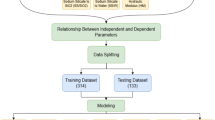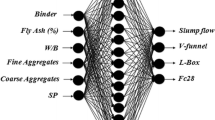Abstract
Fly ash-based geopolymer has been studied extensively in recent years due to its comparable properties to Portland cement and its environmental benefits. However, the uncertainty and complexity of design parameters, such as the SiO2/Na2O mole ratio in alkaline solution, the alkaline solution concentration in liquid phase, and the liquid-to-fly ash mass ratio (L/F), have made it very difficult to create a systematic approach for geopolymer mix design. These mix design parameters, along with fly ash properties and curing conditions (temperature and time), significantly influence key properties of the material, such as setting time and compressive strength. In this study, an artificial neural network (ANN) was used to develop models for predicting the key properties of high-calcium fly ash-based geopolymer according to its mix design parameters. The correlations between experimental measurements and ANN model predictions of setting time, compressive strength, and heat of geopolymerization were established based on the results of tests on 36, 273, and 72 geopolymer mixes, respectively. The results show that the correlations between the experimental measurements and ANN model predictions of the properties studied are all strong. ANN modeling was found to be a suitable computing method to analyze the effects of design parameters on geopolymer properties and showed that L/F exhibited the greatest effect on setting time, alkaline solution concentration had the greatest influence on compressive strength, and a mole ratio larger than 1.5 significantly impacted heat at the geopolymerization peak. The developed ANN models can be used as guidance for mix design of high-calcium fly ash geopolymer in engineering applications.














Similar content being viewed by others
Explore related subjects
Discover the latest articles and news from researchers in related subjects, suggested using machine learning.References
Fernandez-Jimenez A, Palomo A, Lapez-Hombrados C (2006) Engineering properties of alkali-activated fly ash concrete. ACI Mater J 103(2):106–112
Ling Y, Wang K, Wang X, Hua S (2019) Effects of mix design parameters on heat of geopolymerization, set time, and compressive strength of high calcium fly ash geopolymer. Constr Build Mater 228:116763
Garcia-Loderio I, Palomo A, Fernandez-Jimenez A (2007) Alkali-aggregate reaction in activated fly ash systems. Cem Concr Res 37:175–183
Feng D, Tan H, Van Deventer JSJ (2004) Ultrasound enhanced geopolymerisation. J Mater Sci 39:571–580
Zuda L, Pavlik Z, Rovnanikova P, Bayer P, Cerny R (2006) Properties of alkali activated aluminosilicate material after thermal load. Int J Thermophys 27(4):1250–1263
Khale D, Chaudhary R (2007) Mechanism of geopolymerization and factors influencing its development: a review. J Mater Sci 42:729–746
Skvara F, Dolezal J, Svoboda P, Kopecky L, Pawlasova S, Lucuk M, Dvoracek K, Beksa M, Myskova L, Sulc R (2006) Concrete based on fly ash geopolymers. In: The tenth East Asia-Pacific conference on structural engineering and construction, August 3–5, Bangkok, Thailand
Fernandez-Jimenez A, Palomo A, Criado M (2005) Microstructure development of alkali-activated fly ash cement: a descriptive model. Cem Concr Res 35(6):1204–1209
Song X (2007) Development and performance of class f fly ash based geopolymer concretes against sulphuric acid attack. Dissertation, School of Civil and Environmental Engineering, University of New South Wales
Rangan BV (2008) Fly ash-based geopolymer concrete. Research Report GC 4. Curtin University of Technology, Perth, Australia
Ozcan F, Atis CD, Karahan O, Uncuoglu E, Tanyildizi H (2009) Comparison of artificial neural network and fuzzy logic models for prediction of long term compressive strength of silica fume concrete. Adv Eng Softw 40(9):856–863
Yaprak H, Karaci A, Demir I (2011) Prediction of the effect of varying cure conditions and w/c ratio on the compressive strength of concrete using artificial neural networks. Neural Comput Appl 22(1):133–141
Kewalramani MA, Gupta R (2006) Concrete compressive strength prediction using ultrasonic pulse velocity through artificial neural networks. Autom Constr 15(3):374–379
Mozumder R, Laskar A (2015) Prediction of unconfined compressive strength of geopolymer-stabilized clayey soil using artificial neural network. Comput Geotech 69:291–300
Nazari A (2013) Artificial neural networks application to predict the compressive damage of lightweight geopolymer. Neural Comput Appl 23:507. https://doi.org/10.1007/s00521-012-0945-y
Saridemir M (2009) Prediction of the compressive strength of mortars containing metakaolin by artificial neural networks and fuzzy logic. Adv Eng Softw 40(9):920–927
Gupta S (2013) Using artificial neural network to predict the compressive strength of concrete containing nano-silica. Civ Eng Archit 1(3):96–102
Diab A, Elyamany H, Abd Elmoaty M, Shalan A (2014) Prediction of concrete compressive strength due to long term sulfate attack using neural network. Alex Eng J 53(3):627–642
Najafi Z, Ahangari K (2013) The prediction of concrete temperature during curing using regression and artificial neural network. J Eng. https://doi.org/10.1155/2013/946829
Kamalloo A, Ganjkhanlou Y, Aboutalebi S, Nouranian H (2010) Modeling of compressive strength of metakaolin based geopolymers by the use of artificial neural network. IJE Trans A Basics 23(2):145–152
Bondar D (2014) Use of a neural network to predict strength and optimum compositions of natural alumina-silica-based geopolymers. J Mater Civ Eng 26(3):499–503
Nazari A, Riahi S, Khalaj G, Bohlooli H, Kaykha M (2011) Prediction of compressive strength of geopolymers with seeded fly ash and rice husk–bark ash by gene expression programming. Int J Damage Mech 21(8):1202–1226
Yadollahi MM, Benli A, Demirboga R (2015) Prediction of compressive strength of geopolymer composites using an artificial neural network. Mater Res Innov 19(6):453–458
ASTM C618 (2017) Standard specification for coal fly ash and raw or calcined natural pozzolan for use in concrete. ASTM International, Philadelphia
ASTM C305 (2014) Standard practice for mechanical mixing of hydraulic cement pastes and mortars of plastic consistency. ASTM International, Philadelphia
Rupnow TD (2013) Quality control tools to identify source variability of class c fly ash and its impact on freshly mixed cement- fly ash paste. In: 2013 World of coal ash (WOCA), April 22–25, Lexington
ASTM WK27337 (2010) New test method for pocket penetrometer test. ASTM International, Philadelphia
ASTM C109/C109M (2013) Standard test method for compressive strength of hydraulic cement mortars. ASTM International, Philadelphia
Wang K, Ge Z, Grove J, Ruiz JM, Rasmussen R, Ferragut T (2007) Developing a simple and rapid test for monitoring the heat evolution of concrete mixtures for both laboratory and field applications. Center Transp Res Educ, Ames
Arjunan P, Silsbee MR, Roy DM (2001) Chemical activation of low-calcium fly ash part II: effect of mineralogical composition on alkali activation. In: International ash utilization symposium. Center for Applied Energy Research, University of Kentucky. http://www.flyash.info/2001/conprod3/106arjun.pdf. Accessed 20 Feb 2019
Ge Z, Wang K, Gao Z (2012) Prediction of pavement concrete strength development, joint sawing, and opening time using FEMLAB. J Perform Constr Facil 26(2):200–207
Marhadi K, Skrimpas G (2014) Using Johnson distribution for automatic threshold setting in wind turbine condition monitoring system. In: Proceedings of the annual conference of the prognostics and health management society 2014
Seni G, Elder JF (2010) Ensemble methods in data mining: improving accuracy through combining predictions. In: Synthesis lectures on data mining and knowledge discovery. Morgan and Claypool Publishers, San Rafael
Duxson P, Provis J, Lukey G, Mallicoat S, Kriven W, van Deventer J (2005) Understanding the relationship between geopolymer composition, microstructure and mechanical properties. Colloids Surf A Physicochem Eng Asp 269(1–3):47–58
Petermann J, Saeed A, Hammons M (2010) Alkali-activated geopolymers: a literature review. Air Force Research Laboratory Materials and Manufacturing Directorate, Wright-Patterson AFB, Ohio
Acknowledgements
The present study is a part of the first author’s dissertation. He would like to acknowledge the support from the Institute for Transportation and the Department of Civil, Construction and Environmental Engineering at Iowa State University during his PhD study.
Author information
Authors and Affiliations
Corresponding author
Ethics declarations
Conflict of interest
There are no conflicts to declare.
Additional information
Publisher's Note
Springer Nature remains neutral with regard to jurisdictional claims in published maps and institutional affiliations.
Appendix
Appendix
This appendix includes Tables 8, 9, 10, 11, 12, and 13 listing the data sets for setting time, compressive strength, dissolution peak time, dissolution peak heat, geopolymerization peak time, and geopolymerization peak heat from the experiments used for ANN modeling.
Rights and permissions
About this article
Cite this article
Ling, Y., Wang, K., Wang, X. et al. Prediction of engineering properties of fly ash-based geopolymer using artificial neural networks. Neural Comput & Applic 33, 85–105 (2021). https://doi.org/10.1007/s00521-019-04662-3
Received:
Accepted:
Published:
Issue Date:
DOI: https://doi.org/10.1007/s00521-019-04662-3




